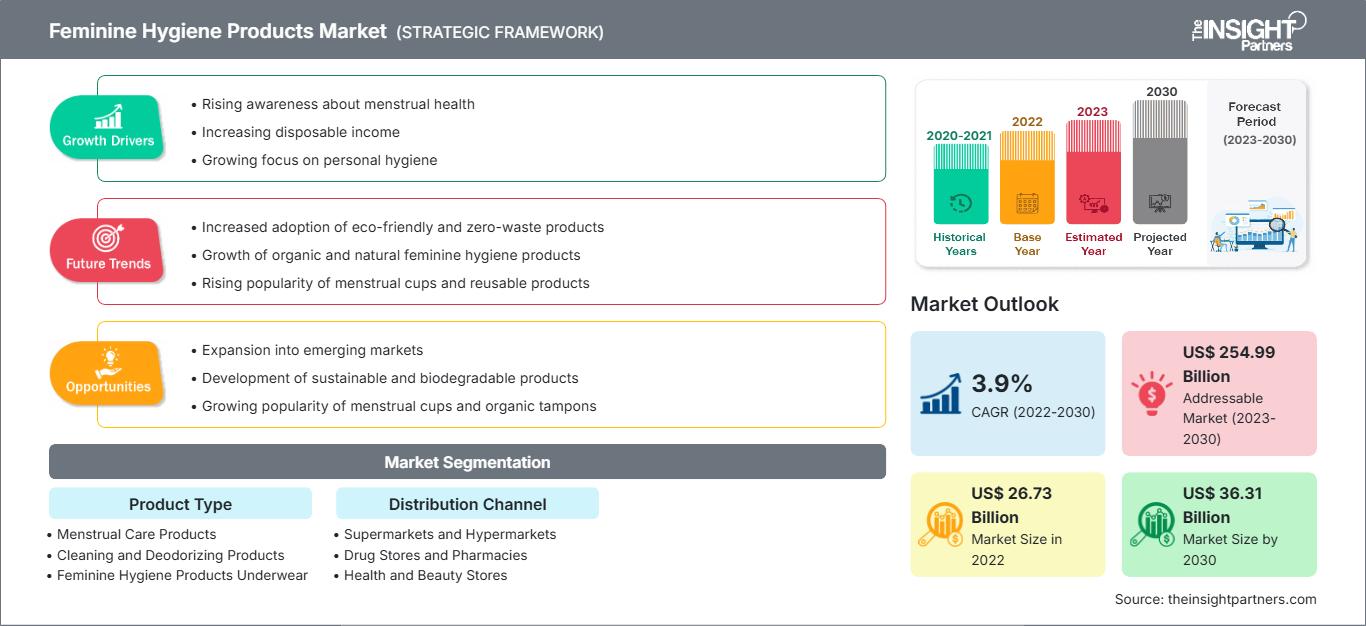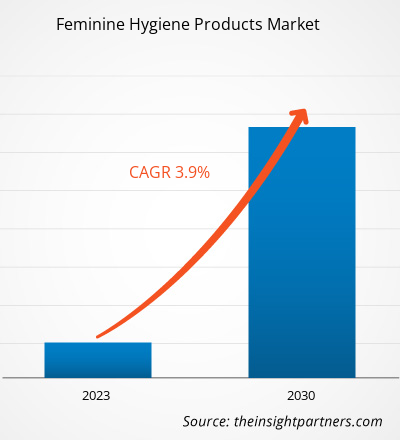[Forschungsbericht] Der Markt für Damenhygieneprodukte wurde im Jahr 2022 auf 26.733,33 Millionen US-Dollar geschätzt und soll bis 2030 voraussichtlich 36.305,29 Millionen US-Dollar erreichen; von 2022 bis 2030 wird eine durchschnittliche jährliche Wachstumsrate (CAGR) von 3,9 % erwartet. Markteinblicke und Analystenmeinung:
Der Markt für Damenhygieneprodukte in Europa wird hauptsächlich durch ein gestiegenes Bewusstsein für die Einhaltung der persönlichen Hygiene und zunehmende Initiativen der Regierungsbehörden in Bezug auf die Damenhygiene angetrieben. Auch aufgrund verschiedener Regierungsinitiativen und Social-Media-Kampagnen steigt das Bewusstsein für die persönliche Hygiene bei Frauen. Diese Initiativen und Kampagnen tragen zu einem besseren Verständnis und einer besseren Akzeptanz von Damenhygieneprodukten bei. Daher treibt das steigende Bewusstsein für persönliche Hygiene das Wachstum des Marktes für Damenhygieneprodukte voran. Regionen wie Nordamerika, Europa und der asiatisch-pazifische Raum sind Zentren von Edgewell Personal Care Co, Kimberly-Clark Corp, Lune Group Oy Ltd, Me Luna Gmbh, Mooncup Ltd, Ontex BV, Essity Ab, Wuka Ltd, Cotton High Tech SL und The Procter & Gamble Co, die eine hohe Nachfrage nach Damenhygieneprodukten generieren. Daher treibt die Präsenz solcher Unternehmen das Wachstum des globalen Marktes für Damenhygieneprodukte voran.
Wachstumstreiber und Herausforderungen:
Strategische Initiativen wichtiger Marktteilnehmer haben das Wachstum des globalen Marktes für Damenhygieneprodukte vorangetrieben. Hersteller investieren massiv in Forschungs- und Entwicklungsprojekte, Partnerschaften, Expansionspläne und Kooperationen, um innovative Produkte auf den Markt zu bringen und eine große Verbraucherbasis anzusprechen. So brachte Pee Safe im Juni 2020 eine neue Reihe von Intimhygieneprodukten auf den Markt, darunter Unterwäsche-Desinfektionsspray, wiederverwendbare Damenbinden, oxo-biologisch abbaubare Einwegbeutel und ein Intimhygienepuder. Wichtige Marktteilnehmer ergreifen strategische Initiativen wie Fusionen und Übernahmen, um ihr Produktportfolio und ihre geografische Präsenz zu erweitern. So gab beispielsweise das Unternehmen Edgewell Personal Care im November 2022 die Übernahme von Billie Inc. bekannt. Ziel der Übernahme war die Erweiterung des Produktportfolios führender Marken für Damenrasur und Körperpflege.
Darüber hinaus erfreuen sich natürliche und saubere Haarentfernungsprodukte weltweit zunehmender Beliebtheit, da das Bewusstsein für die schädlichen Auswirkungen von Chemikalien zunimmt und die Tendenz zu umweltfreundlichen und sauberen Körperpflegeprodukten steigt. Dieser Trend hat Hersteller dazu veranlasst, natürliche Produkte basierend auf Kundenanforderungen zu entwickeln. So brachte beispielsweise die Reckitt Benckiser Group Plc im Jahr 2022 die Haarentfernungscreme-Reihe Veet Pure auf den Markt und formulierte damit ihre Produkte neu. Die Produktpalette umfasst natürliche Gurkenextrakte, Aloe Vera und Traubenkernöl. Solche Produkteinführungen und andere Strategien zur Befriedigung der steigenden Verbrauchernachfrage fördern das Marktwachstum.
Passen Sie diesen Bericht Ihren Anforderungen an
Sie erhalten kostenlos Anpassungen an jedem Bericht, einschließlich Teilen dieses Berichts oder einer Analyse auf Länderebene, eines Excel-Datenpakets sowie tolle Angebote und Rabatte für Start-ups und Universitäten.
Markt für Damenhygieneprodukte: Strategische Einblicke

-
Holen Sie sich die wichtigsten Markttrends aus diesem Bericht.Dieses KOSTENLOSE Beispiel umfasst Datenanalysen, die von Markttrends bis hin zu Schätzungen und Prognosen reichen.
Der globale Markt für Damenhygieneprodukte ist nach Produkttyp, Vertriebskanal und Geografie segmentiert. Basierend auf dem Produkttyp ist der Markt für Damenhygieneprodukte in Menstruationspflegeprodukte, Reinigungs- und Desodorierungsprodukte und Damenhygieneunterwäsche segmentiert. Auf der Grundlage des Vertriebskanals ist der Markt für Damenhygieneprodukte in Supermärkte und Hypermärkte, Drogerien und Apotheken, Gesundheits- und Schönheitsgeschäfte, Online-Einzelhandel und andere segmentiert. Der Markt für Damenhygieneprodukte ist geografisch in Nordamerika (USA, Kanada und Mexiko), Europa (Deutschland, Frankreich, Italien, Großbritannien, Russland und übriges Europa), Asien-Pazifik (Australien, China, Japan, Indien, Südkorea und übriger Asien-Pazifik-Raum), Naher Osten und Afrika (Südafrika, Saudi-Arabien, Vereinigte Arabische Emirate und übriger Naher Osten und Afrika) und Süd- und Mittelamerika (Brasilien, Argentinien und übriges Süd- und Mittelamerika).
Segmentanalyse:
Basierend auf dem Produkttyp ist der Markt für Damenhygieneprodukte in Menstruationspflegeprodukte, Reinigungs- und Desodorierungsprodukte sowie Damenhygieneunterwäsche segmentiert. Das Segment Menstruationspflegeprodukte hatte einen erheblichen Anteil am Wachstum des Marktes für Damenhygieneprodukte und wird im Prognosezeitraum voraussichtlich ein erhebliches Wachstum verzeichnen. Menstruationspflegeprodukte, darunter Menstruationsbinden, Periodenslips, Slipeinlagen, Damentücher, Tampons und Menstruationstassen, Damenbinden und Binden, gewinnen aufgrund des steigenden Bewusstseins für Damenhygiene bei Frauen weltweit an Bedeutung. Darüber hinaus fördert die zunehmende Verwendung dieser Produkte das Umweltbewusstsein der Bevölkerung. Daher greifen berufstätige Frauen und andere umweltbewusste Bevölkerungsgruppen auf bequeme Einweg-Menstruationsprodukte zurück.
Menstruationspflegeprodukte werden in der Regel entsorgt und landen auf Mülldeponien, wo sie enorme Mengen an nicht biologisch abbaubarem Abfall erzeugen. Dadurch verbleiben sie in Form von Mikroplastik in der Umwelt und stellen eine erhebliche Bedrohung für aquatische und terrestrische Ökosysteme dar. Aufgrund des gestiegenen Bewusstseins für dieses Problem steigen viele auf wiederverwendbare Menstruationsprodukte um, beispielsweise Menstruationstassen und -scheiben sowie wiederverwendbare Binden aus Stoff. Laut einem auf der BBC-Website und im Google Trends-Suchindex veröffentlichten Artikel haben die Suchanfragen nach wiederverwendbaren Periodenprodukten jedes Jahr zugenommen.
Regionale Analyse:
Geografisch ist der Markt für Damenhygieneprodukte in fünf Hauptregionen unterteilt: Nordamerika, Europa, Asien-Pazifik, Süd- und Mittelamerika sowie Naher Osten und Afrika. Der globale Markt für Damenhygieneprodukte wurde von Nordamerika dominiert und verzeichnete im Jahr 2022 rund 5 Milliarden US-Dollar. Europa ist ein zweitgrößter Marktteilnehmer mit einem Anteil von über 20 % am Weltmarkt. Der asiatisch-pazifische Raum wird im Prognosezeitraum voraussichtlich mit einer durchschnittlichen jährlichen Wachstumsrate (CAGR) von über 5 % wachsen. Der nordamerikanische Markt für Damenhygieneprodukte ist in die USA, Kanada und Mexiko unterteilt. Das Wachstum des nordamerikanischen Marktes für Damenhygieneprodukte ist auf einen höheren Lebensstandard, bessere Hygienepraktiken und ein höheres Einkommensniveau für Frauen zurückzuführen. Die Branche erlebt kontinuierliche Innovationen bei Damenhygieneprodukten, wobei Unternehmen neue und verbesserte Produkte auf den Markt bringen, um den unterschiedlichen Bedürfnissen und Vorlieben der Kundinnen gerecht zu werden. Darüber hinaus hat die wachsende Besorgnis über Umweltprobleme, wie die zunehmende Plastikbevölkerung und die globale Erwärmung, Frauen dazu ermutigt, sich für nachhaltige und umweltfreundliche Produkte zu entscheiden. In Nordamerika landen jährlich rund 20 Milliarden Damenbinden, Tampons und Applikatoren auf Mülldeponien. Produkte wie Menstruationstassen und Stoffbinden erfreuen sich aufgrund ihrer Kosteneffizienz und geringeren Umweltbelastung zunehmender Beliebtheit. Die steigende Nachfrage nach nachhaltigen und umweltfreundlichen Damenhygieneprodukten hat zu Produktinnovationen und der Markteinführung neuer Produkte geführt. Im Dezember 2022 kündigte Trace Femcare beispielsweise die Einführung von Tampons aus klimafreundlicher Baumwolle und regenerativen Hanffasern an. Die Produkte tragen der zunehmenden Plastikverschmutzung und der durch Mehrweg-Tampons verursachten globalen Erwärmung Rechnung. Daher beeinflussen alle oben genannten Faktoren das Wachstum des Marktes für Damenhygieneprodukte in Nordamerika.
Branchenentwicklungen und zukünftige Chancen:
Nachfolgend sind verschiedene Initiativen der wichtigsten Akteure auf dem Markt für Damenhygieneprodukte aufgeführt:
- Im November 2021 brachte Ontex BV seine Marke NAT in China auf den Markt. Die eingeführten Produkte waren Tampons, Binden, Slipeinlagen und Menstruationshöschen.
- Im Mai 2021 gab Poise, eine Marke von Kimberly Clark, seine Partnerschaft mit Whitney Port bekannt und brachte seine 2-in-1-Einlagen und Binden auf den Markt.
Markt für Damenhygieneprodukte
Die Analysten von The Insight Partners haben die regionalen Trends und Faktoren, die den Markt für Damenhygieneprodukte im Prognosezeitraum beeinflussen, ausführlich erläutert. In diesem Abschnitt werden auch die Marktsegmente und die geografische Lage in Nordamerika, Europa, dem asiatisch-pazifischen Raum, dem Nahen Osten und Afrika sowie Süd- und Mittelamerika erörtert.Umfang des Marktberichts über Damenhygieneprodukte
| Berichtsattribut | Einzelheiten |
|---|---|
| Marktgröße in 2022 | US$ 26.73 Billion |
| Marktgröße nach 2030 | US$ 36.31 Billion |
| Globale CAGR (2022 - 2030) | 3.9% |
| Historische Daten | 2020-2021 |
| Prognosezeitraum | 2023-2030 |
| Abgedeckte Segmente |
By Produkttyp
|
| Abgedeckte Regionen und Länder |
Nordamerika
|
| Marktführer und wichtige Unternehmensprofile |
|
Dichte der Marktteilnehmer für Damenhygieneprodukte: Verständnis ihrer Auswirkungen auf die Geschäftsdynamik
Der Markt für Damenhygieneprodukte wächst rasant. Die steigende Nachfrage der Endverbraucher ist auf Faktoren wie veränderte Verbraucherpräferenzen, technologische Fortschritte und ein stärkeres Bewusstsein für die Produktvorteile zurückzuführen. Mit der steigenden Nachfrage erweitern Unternehmen ihr Angebot, entwickeln Innovationen, um den Bedürfnissen der Verbraucher gerecht zu werden, und nutzen neue Trends, was das Marktwachstum weiter ankurbelt.

- Holen Sie sich die Markt für Damenhygieneprodukte Übersicht der wichtigsten Akteure
Die steigende Alphabetisierungsrate von Frauen und das größere Bewusstsein für Menstruationshygiene trieben den Markt für Damenhygieneprodukte vor dem Ausbruch der COVID-19-Pandemie maßgeblich an. Die Konsumgüterindustrie war im ersten Quartal 2020 jedoch mit den negativen Auswirkungen der Pandemie konfrontiert. Die COVID-19-Pandemie führte in den ersten Monaten des Jahres 2020 auch zu einer Wirtschaftsrezession, die Verbraucher mit niedrigem und mittlerem Einkommen in finanzielle Schwierigkeiten brachte. Infolgedessen kauften die Menschen nur noch lebensnotwendige Produkte wie Lebensmittel und wichtige medizinische Produkte, was zu einem Rückgang der Umsätze mit Damenhygieneprodukten führte.
Viele Unternehmen erholten sich, als die Regierungen verschiedener Länder die Beschränkungen nach den ersten Monaten des Lockdowns im Jahr 2020 lockerten. Die Einführung des COVID-19-Impfstoffs brachte weitere Linderung der belastenden Pandemiesituation und führte zu einem Anstieg der Geschäftstätigkeit. Die Wiederaufnahme des Betriebs in den Produktionsstätten wirkte sich positiv auf den Markt für Damenhygieneprodukte aus und führte zu einer Erholung der Produktion von Damenhygieneprodukten. Die Hersteller überwanden die Lücke zwischen Angebot und Nachfrage, da sie mit voller Kapazität arbeiten durften.
Wettbewerbslandschaft und Schlüsselunternehmen:
Zu den führenden Akteuren auf dem globalen Markt für Damenhygieneprodukte gehören unter anderem Edgewell Personal Care Co, Kimberly-Clark Corp, Lune Group Oy Ltd, Me Luna Gmbh, Mooncup Ltd, Ontex Bv, Essity Ab, Wuka Ltd, Cotton High Tech SL und The Procter & Gamble Co. Diese Akteure bieten hochmoderne Damenhygieneprodukte mit innovativen Funktionen, um den Verbrauchern ein erstklassiges Erlebnis zu bieten.
- Historische Analyse (2 Jahre), Basisjahr, Prognose (7 Jahre) mit CAGR
- PEST- und SWOT-Analyse
- Marktgröße Wert/Volumen – Global, Regional, Land
- Branchen- und Wettbewerbslandschaft
- Excel-Datensatz
Aktuelle Berichte
Erfahrungsberichte
Grund zum Kauf
- Fundierte Entscheidungsfindung
- Marktdynamik verstehen
- Wettbewerbsanalyse
- Kundeneinblicke
- Marktprognosen
- Risikominimierung
- Strategische Planung
- Investitionsbegründung
- Identifizierung neuer Märkte
- Verbesserung von Marketingstrategien
- Steigerung der Betriebseffizienz
- Anpassung an regulatorische Trends






















 Kostenlose Probe anfordern für - Markt für Damenhygieneprodukte
Kostenlose Probe anfordern für - Markt für Damenhygieneprodukte